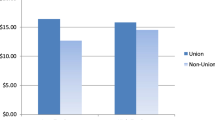Abstract
Using unskilled labor wage rates and union contract scores derived from a sample of 500 U.S. manufacturing contracts, this study finds that in 1975 there was considerable variation in unions’ abilities to deliver higher wages and desirable nonwage contractual provisions to their members (though it is clear that the stronger unions have bargained high levels of both wages and nonwage items). There are a variety of union power, employee quality, union preference, and employer cost variables which impact upon the bargaining choices made between wages and nonwage provisions, and it appears that union strength tilts the compensation package toward wages.
Similar content being viewed by others
References
Anderson, John, “Bargaining Outcomes: An IR Systems Approach,”Industrial Relations, 18 (Spring 1979), 127–143.
Ashenfelter, Orley and George Johnson, “Unionism, Relative Wages, and Labor Quality in U.S. Manufacturing Industries,”International Economic Review, 13 (October 1972), 488–508.
Brown, Charles and James Medoff, “Trade Unions in the Production Process,”Journal of Political Economy, 80 (June 1978), 355–378.
Donsimoni, Marie-Paule and Robert Shakotko, “Unionism and the Structure of Total Compensation,” Columbia University Department of Economics Discussion Paper No. 21, August 1979.
Freeman, Richard B., “Individual Mobility and Union Voice in the Labor Market,”American Economic Review, 66 (May 1976), 361–368.
_____, “The Effect of Trade Unionism on Fringe Benefits,” NBER Working Paper No. 292, 1978.
_____, “The Effect of Unionism on Worker Attachment to Firms,”Journal of Labor Research, 1 (Spring 1980), 29–61.
_____, and James Medoff, “New Estimates of Private Sector Unionism in the United States,”Industrial and Labor Relations Review, 32 (January 1979), 143–174.
Gerhart, Paul, “Determinants of Bargaining Outcomes in Local Government Negotiations,”Industrial and Labor Relations Review, 29 (April 1976), 331–351.
Hendricks, Wallace, “Labor Market Structure and Union Wage Levels,”Economic Inquiry, 13 (September 1975), 401–416.
_____, Peter Feuille and Carol Szerszen, “Regulation, Deregulation, and Collective Bargaining in Airlines,”Industrial and Labor Relations Review, 34 (October 1980), 67–81.
_____, and Lawrence M. Kahn, “The Determinants of Bargaining Structure in U.S. Manufacturing Industries,” paper presented at the North American Meetings of the Econometric Society, Atlanta, Georgia, December, 1979.
Kahn, Lawrence, M., “Union Impact: A Reduced Form Approach,”The Review of Economics and Statistics, 59 (November 1977), 503–507.
_____, “Unionism and Relative Wages: Direct and Indirect Effects,”Industrial and Labor Relations Review, 32 (July 1979), 520–532.
Kaysen, Carl and Donald F. Turner,Antitrust-Policy, (Cambridge, Mass., Harvard University Press, 1965).
Kochan, Thomas and Richard Block, “An Interindustry Analysis of Bargaining Outcomes: Preliminary Evidence From Two-Digit Industries,”The Quarterly Journal of Economics, 91 (August 1977), 431–452.
_____, and Hoyt Wheeler, “Municipal Collective Bargaining: A Model and Analysis of Bargaining Outcomes,”Industrial and Labor Relations Review, 29 (October 1975), 46–66.
Lewis, H. Gregg,Unionism and Relative Wages in the United States, (Chicago, University of Chicago Press, 1963).
Medoff, James, “Layoffs and Alternatives Under Trade Unions in U.S. Manufacturing,”American Economic Review, 69 (June 1979), 380–395.
Perry, James L. and Charles H. Levine, “An Interorganizational Analysis of Power, Conflict, and Settlements in Public Sector Collective Bargaining,”American Political Science Review, 70 (December 1976), 1185–1201.
Rice, Robert, “The Economic Determinants of Private Wage Settlements,” unpublished Ph.D. dissertation, Columbia University, 1966.
Schwartzman, David and Joan Bodoff, “Concentration in Regional and Local Industries,”Southern Economic Journal, 37 (January 1971), 343–348.
Smith, Robert S., “Compensating Wage Differentials and Public Policy: A Review,”Industrial and Labor Relations Review, 32 (April 1979), 339–352.
U.S. Bureau of Labor Statistics,Industry Wage Surveys, (Washington, D.C., U.S. Government Printing Office, various issues).
U.S. Department of Commerce,1972 Census of Manufactures, (Washington, D.C., U.S. Government Printing Office, 1972).
Viscusi, W. Kip, “Unions, Labor Market Structure, and the Welfare Implications of the Quality of Work,”Journal of Labor Research, 1 (Spring 1980), 175–192.
_____, “Wealth Effects and Earnings Premiums for Job Hazards,”The Review of Economics and Statistics, 60 (August 1978), 408–416.
Weiss, Leonard, “Concentration and Labor Earnings,”American Economic Review, 56 (March 1966), 96–117.
_____, (1966a), “Appendix to Concentration and Labor Earnings,” mimeo, 1966.
Author information
Authors and Affiliations
Additional information
The authors, associate professors at the University of Illinois, are very grateful to Christopher Pawlowicz, Ronald Seeber, and Roger Wolters for their help in gathering data. They also are grateful to the Office of the Assistant Secretary for Policy, Evaluation and Research of the U.S. Department of Labor and to the Research Board of the University of Illinois for financially supporting this research. Such support in no way implies, however, that the Department or the University endorses the methods or conclusions in this study.
Rights and permissions
About this article
Cite this article
Feuille, P., Hendricks, W.E. & Kahn, L.M. Wage and nonwage outcomes in collective bargaining: Determinants and tradeoffs. Journal of Labor Research 2, 39–53 (1981). https://doi.org/10.1007/BF02685121
Issue Date:
DOI: https://doi.org/10.1007/BF02685121




